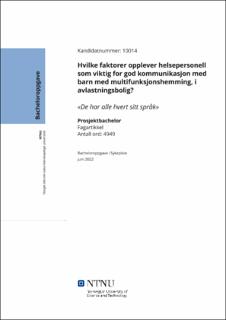| dc.contributor.advisor | Moksnes, Unni Karin | |
| dc.contributor.author | Okstad, Gunnhild | |
| dc.date.accessioned | 2022-07-19T17:20:52Z | |
| dc.date.available | 2022-07-19T17:20:52Z | |
| dc.date.issued | 2022 | |
| dc.identifier | no.ntnu:inspera:110921428:46745339 | |
| dc.identifier.uri | https://hdl.handle.net/11250/3006948 | |
| dc.description.abstract | Sammendrag
Bakgrunn: Det «å bli sett» både bokstavelig og i overført betydning, er et grunnleggende behov hos mennesket (1). Barn og unge med multifunksjonshemming har ofte utfordringer med å få uttrykt seg, samt å forstå hva andre prøver å formidle (2). Sensoriske, kognitive og motoriske funksjonsnedsettelser kan skape begrensninger når det kommer til kommunikasjon gjennom verbalt språk og symboler (2). Mange av disse barna har behov for alternativ supplerende kommunikasjon (ASK) og de er prisgitt omgivelsenes respons og støtte for å få utnyttet sitt kommunikative potensiale og uttrykt sine tanker og behov (3).
Hensikt: Å undersøke hvilke faktorer helsepersonell opplever som viktig for god kommunikasjon med barn med multifunksjonshemming i avlastningsbolig.
Metode: Det ble benyttet en kvalitativ forskningsmetode, med gjennomføring av to semistrukturerte gruppeintervjuer, med to sykepleiere og to vernepleiere ved den aktuelle avlastningsboligen.
Resultat: Informantene beskrev en stor variasjon i ulike kommunikasjonsmetoder blant barna og det ble sagt: «de har alle hvert sitt språk». For å lære seg det enkelte barnets språk ble samarbeid med skole og barnehage, samt kontinuitet og tid med barnet trukket frem som viktig. Flere av informantene ønsket mer kursing og opplæring. Helsepersonells relasjonskompetanse i form av kunnskap om det enkelte barnet og nærhet gjennom fysisk tilstedeværelse og aktiv lytting ble også trukket frem.
Konklusjon: Barn og unge med multifunksjonshemming har et stort potensialet for kommunikasjon og deltagelse, men det avhenger av hvem som møter dem og hvilken kompetanse de innehar (4). Det forutsetter at de ansatte blir godt kjent med barna og lærer seg det enkelte barnets språk. Informantenes erfaringer viser også at nærhet er et viktig verktøy i kommunikasjon med barna. Personalets holdninger og forståelse for at absolutt alle har et språk og en måte å kommunisere på, har stor betydning for hvilken respons barna får på sine uttrykk.
Nøkkelord: Barn, multifunksjonshemming, kommunikasjon, ASK, avlastningsbolig | |
| dc.description.abstract | Abstract
Background: "Being seen" both literally and in transferred meaning is a fundamental need of man (1). Children with multi-disabilities often have challenges in expressing themselves, as well as understanding what others are trying to convey (2). Sensory, cognitive and motor impairments can create limitations when it comes to communication through verbal language and symbols (2). Many of these children need alternative augmentative communication (AAC) and they are dependent of the environment's response and support in order to exploit their communicative potential and express their thoughts and needs (3).
Aims: To investigate which factors health personnel perceive as important for good communication with children with multi-disability in respite care homes.
Method: A qualitative research method was used and two semi-structured group interviews was conducted, with two nurses and two social educators.
Result: The informants described a wide variation in different communication methods among the children and said: "They all have their own language". In order to learn the individual child's language, cooperation with school and kindergarten, as well as continuity and time with the child, was highlighted as important. Several of the informants wanted more training and training. Health personnel's relational competence in the form of knowledge about the individual child and closeness through physical presence and active listening was also highlighted
Conclusion: Children with multi-disability have a great potential for communication and participation, but it depends on who meets them and what competence they possess (4). This requires that the employees get to know the children well and learn the individual child's language. The informants' experiences also show that proximity is a useful tool in communication with the children. The staff's attitudes and understanding of that absolutely every child has a language and a way of communicating, is of great importance for the response the children receive to their expressions.
Keywords: Children, multi-disability, communication, AAC, respite care homes | |
| dc.language | nob | |
| dc.publisher | NTNU | |
| dc.title | Hvilke faktorer opplever helsepersonell som viktig for god kommunikasjon med barn med multifunksjonshemming, i avlastningsbolig? | |
| dc.type | Bachelor thesis | |
